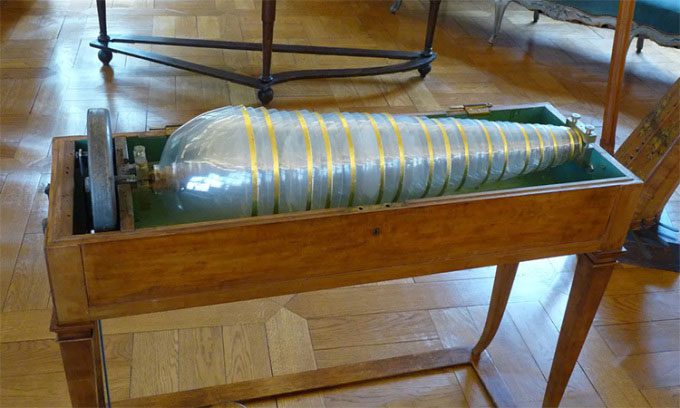The Glass Armonica is regarded as a groundbreaking invention in music by Benjamin Franklin, known for its ability to produce extremely creative and rich notes with 37 delicate glass bowls.

The Glass Armonica – an instrument consisting of 37 delicate glass bowls. (Photo: Ji-Elle/Wikimedia).
As a founding father of the United States, politician, and scientist Benjamin Franklin (1706 – 1790) is famous for numerous inventions such as the Franklin stove, the urinary catheter, and the lightning rod. Franklin was also a talented musician, so it’s perhaps no surprise that he was inspired to invent one of his most intriguing products, the Glass Armonica, after hearing a unique sound at a concert in 1761.
At the concert, Franklin observed a performer playing a set of wine glasses tuned with water. He then used 37 glass bowls marked with different colors and assembled them into a spinning apparatus that the player could operate with a foot pedal. This new instrument was easier to handle and allowed the player to produce up to 10 notes simultaneously.
The Glass Armonica has been utilized by many musicians over the years. For instance, in the seventh movement of the suite “The Carnival of the Animals,” composer Camille Saint-Saëns employed this instrument to evoke a mysterious underwater sensation. Mozart composed music for the Glass Armonica, and even the French Queen Marie Antoinette knew how to play it. Franklin’s influence extended beyond classical music, as some modern artists like Tom Waits, David Gilmour, and Björk also use the instrument.
Artist William Zeitler performing with the Glass Armonica. (Video: William Zeitler)
However, the unique sound of the Glass Armonica has led some to consider it the “most dangerous musical instrument in the world.” In the 18th century, the Glass Armonica fell out of favor due to concerns that it could drive listeners mad. At that time, German musicologist Friedrich Rochlitz advised people to avoid playing the instrument. “The Armonica overstimulates the nerves, leading players into a state of persistent depression, which can result in a slow self-destruction,” he stated.
One of the early proponents of the Glass Armonica was Franz Anton Mesmer, a practitioner of hypnosis considered a precursor to modern hypnotism. Mesmer maximized the sound advantages of the Glass Armonica as a backdrop for his hypnotic performances. According to an investigation in 1784 by several leading scientists in France, including Franklin, the music Mesmer used merely created an atmosphere that made people believe his techniques were beneficial, while in reality, they were not.
However, entering a temporary hypnotic state does not align with Rochlitz’s description of “slow self-destruction.” So, what exactly caused the fear surrounding the Glass Armonica?
Modern musicologists explore why the melodies of the Glass Armonica can cause disorientation. This instrument produces sound at frequencies approximately between 1,000 – 4,000 Hertz. At this frequency, the human brain struggles to determine where the sound is coming from, which may explain why, for some, listening to the Glass Armonica can be an uncomfortable experience.
Experts suggest there is also a more practical reason why people stopped playing the Glass Armonica for an extended period. The way music is performed changed, with concerts moving to larger venues, leading to issues with sound amplification. Glass Armonica artist William Zeitler explains that while pianos can be adjusted to produce louder sounds, doing so with an instrument made of delicate glass bowls is not so straightforward.




















































